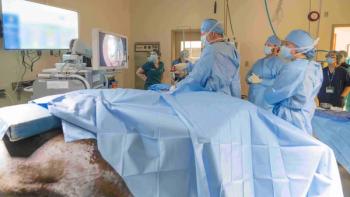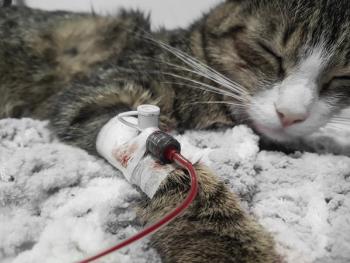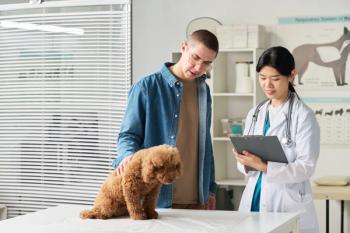
Uroabdomen (Proceedings)
Leakage of urine into the abdominal cavity is a common condition following vehicular trauma in small animals.
Leakage of urine into the abdominal cavity is a common condition following vehicular trauma in small animals. Other causes of uroabdomen include rupture of the upper or lower urinary tract secondary to calculi obstruction or neoplasia, as well as iatrogenic injury.
Early clinical signs of uroabdomen may be nonspecific. In is not uncommon for animals with uroabdomen to still have normal urination habits. As the condition progresses, owners may describe acute onset of severe lethargy, anorexia, vomiting, restlessness, or reluctance to lie down. Animals with severe abdominal pain may display a praying position. A fluid wave may sometimes be elicited on abdominal ballottement. Animals may also present in hypovolemic and/or septic shock with marked abdominal pain and abdominal distention. Signs of hypovolemic shock include pale, tacky mucous membranes, tachycardia, and weak peripheral pulses. These animals may have cardiac dysrrhythmias, respiratory compromise, and altered mentation.
Aside from standard laboratory evaluation, including complete blood count, biochemical profile, electrolyte panel, and urinalysis, an abdominocentesis should also be performed in animals thought to have uroabdomen. If fluid is balloted, a single midline tap may be done using a 20 gauge, 1-inch needle. Lesser amounts of abdominal fluid may require a four-quadrant abdominocentesis or diagnostic peritoneal lavage. The four-quadrant technique is usually performed with the animal standing or in lateral recumbency. The bladder is expressed to avoid inadvertent cystocentesis and the abdomen is clipped and antiseptically prepped. A 20 gauge, 1-inch needle is inserted into each quadrant: cranial and caudal to the umbilicus and on either side of midline. Fluid should be allowed to drip from the hub of the needle into an EDTA tube (purple top). In animals with uroabdomen, a diagnostic peritoneal lavage is seldom necessary, as fluid should be readily retrieved from the peritoneal cavity. Ultrasound may also be used to help locate pockets of fluid and avoid unintended injury of the abdominal viscera.
Collected fluid should be examined cytologically and protein quantitation and total nucleated cell count should also be performed. The hallmark diagnostic test for uroabdomen is measurement of the creatinine level in the abdominal fluid compared to the serum creatinine level. Fluid creatinine levels are typically 2 to 4 times higher than serum levels. Potassium can also be measured and compared between fluid and serum. Although urea is known to rapidly equilibrate between the abdominal fluid and blood due to the small size of the molecule, it is often markedly elevated in the abdominal fluid as well and can be measured quickly using dipstick measurement (Azostix®).
Patients diagnosed with uroabdomen are not surgical emergencies. Often these animals have significant electrolyte abnormalities and acid-base imbalances and should be stabilized over a 12 to 24 hour period before going to surgery. Stabilization includes intravenous fluid therapy, urethral catheterization, and peritoneal drainage. Drainage of the peritoneal cavity can be accomplished through insertion of a multifenestrated large-gauge catheter. This catheter can often be placed with only mild sedation and a local anesthetic block. Both the peritoneal drainage catheter and the urinary catheter should be connected to closed collection systems so that fluid losses can be quantitated and replaced. Thoracic radiographs and electrocardiography are also indicated in animals that have been involved in vehicular trauma. Electrocardiography is also indicated in animals with significantly elevated serum potassium.
Uroabdomen secondary to a traumatic incident is often due to lacerations of the urinary bladder or proximal urethra. Damage to the upper urinary tract usually occurs secondary to urolith obstruction, penetrating abdominal wounds, or neoplasia. Contrast radiographic studies should be performed after stabilization but prior to surgery to identify the exact location of the tear. Positive-contrast cystourethrography is utilized for suspected lower urinary tract injuries, while an excretory urogram should be use if renal or ureter damage is suspected. Definitive surgical treatment is based on the site of urine leakage. Surgical repair of the bladder is most commonly indicated in animals with traumatic uroabdomen. While spontaneous closure of bladder tears have been reported, the treatment of choice is still surgical repair.
References
Gannon KM, Moses L. Uroabdomen in dogs and cat. Compend Vet Contin Educ Pract Vet 2002;24:604-612
Newsletter
From exam room tips to practice management insights, get trusted veterinary news delivered straight to your inbox—subscribe to dvm360.




